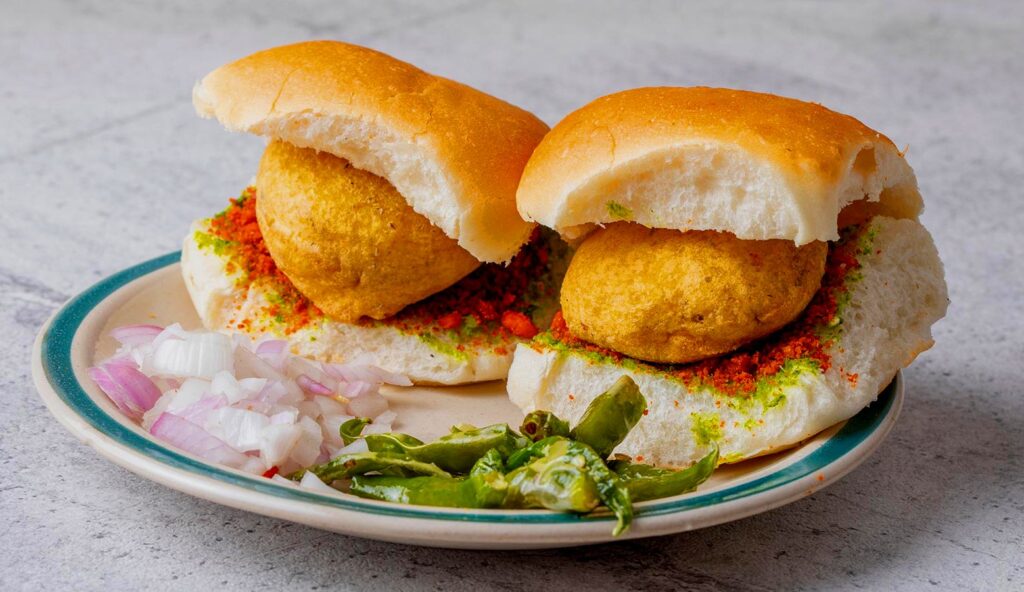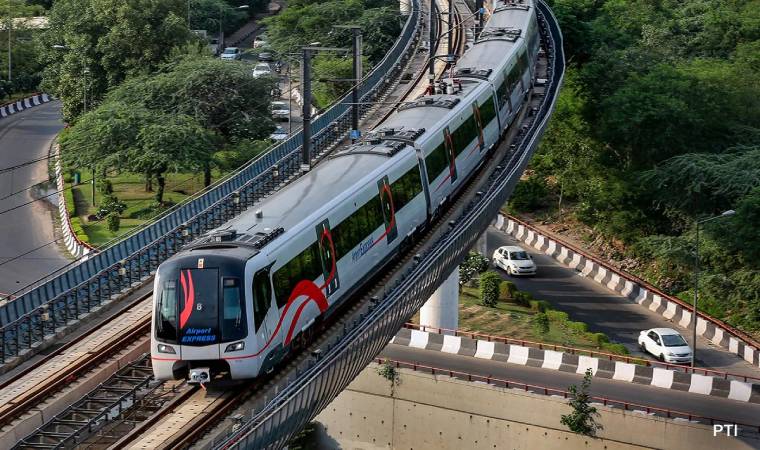India’s two most iconic metropolises, Delhi and Mumbai, are not just different in their geography, pace of life, or architecture. They are culinary worlds apart, especially when it comes to street food. From the spicy, smoky alleyways of Delhi to the bustling beaches and railway platforms of Mumbai. Both cities carry distinctive food cultures that reflect their people, history, and rhythm. One noticeable reflection of this difference lies in two popular dishes- Delhi’s love for momos and Mumbai’s obsession with vada pav.
What’s fascinating is how these two snacks, though now available in both cities, often do not impress the natives of the other. A Mumbaikar may find Delhi’s version of vada pav missing the authentic punch, just as a Delhite may feel underwhelmed by Mumbai’s version of momos. This isn’t about superiority; it is about identity. Street food in both cities is deeply tied to local taste preferences, preparation styles, and social experiences. To appreciate the nuances, one must first understand the broader food story each city tells.
Momos of Delhi: A Bite into North-East and Tibetan Influences
(Delhi and Mumbai)

Momos, a humble steamed dumpling with roots in Tibet and the North-East of India, have found a massive fan base in Delhi. Over the past two decades, the capital has transformed this simple dish into a citywide obsession. From student canteens to upscale cafes, from makeshift stalls in Lajpat Nagar to late-night carts in North Campus- Momos are everywhere.
What makes Delhi’s momos distinct is their evolving diversity?
They come not just steamed, but also tandoori, fried, afghani, gravy-drenched, or even cheesy. Often served with a fiery red chutney that can surprise even the most adventurous food lovers. The momo here is not just a snack. It is a quick meal, a comfort food, and even a weekend craving.
When this same momo reaches Mumbai, it often undergoes a gentler transformation. The chutney may be toned down, the fillings might change, and the cooking methods lean more toward the steamed variety. While Mumbai has embraced momos, particularly among its youth, they haven’t become a defining part of the city’s foodscape the way they have in Delhi.
Mumbai’s Vada Pav: More Than a Snack
On the other end of the street food spectrum stands the mighty vada pav. Mumbai’s favourite grab-and-go meal. It is filling, spicy, inexpensive, and portable, making it a natural fit for the fast-paced life of any Mumbaikar. Whether you are a corporate employee stepping out of Churchgate station, a student from Dadar, or a shopkeeper in Andheri, vada pav is part of your everyday vocabulary.
What makes the vada pav special is its simplicity?
A deep-fried spicy potato patty (vada) nestled between a pav (soft bun), served with green chutney, dry garlic masala, and sometimes a fried green chilly. It’s straightforward appearance might fool you. A great vada pav is an art. The perfect balance of spice, crunch, softness, and heat is what makes it unforgettable.

When Delhi vendors try to replicate it, the ingredients or proportions often vary slightly.The chutney changes, the pav gets toasted differently, and the vada often lacks that signature Maharashtrian masala punch. As a result, Delhi’s version often feels like a tribute rather than a replication. Similarly, a Delhi-style momo stall in Mumbai may not capture the aggressive chutney flavour or the creative fusions that Dilliwale expect.
The Science of Taste: Regional Preferences and Familiar Comfort / Delhi and Mumbai
Food is never just about ingredients. It is about memories, environment, and expectations. Delhiites, used to spicy, masaledar, rich food from North Indian and Mughlai traditions, enjoy dishes that have layers of flavour and boldness. On the other hand, Mumbaikars, influenced by coastal, Maharashtrian, and Parsi food, prefer sharp, tangy, and spicy but often cleaner flavours.
The way people perceive similar dishes depends largely on their taste preferences. A vada pav in Delhi might be criticized by Mumbaikars for lacking the bite of the original. Just as Delhiites may find Mumbai’s momos too bland or uniform. But neither is wrong. Their palate, shaped by what they grew up eating, simply roots their preferences.
Beyond Momos and Vada Pav: The Wider Street Food Scene
Both cities offer a treasure trove of street food beyond these flagship snacks. In Delhi, chaat is the undisputed king. From aloo tikki and golgappe to raj kachori and papdi chaat, the capital’s love for tangy, crunchy, spicy flavours shines through. Every corner of Old Delhi echoes with the sizzle of tikkis and the clink of steel bowls being filled with curd, chutney, and sev.
Paranthe Wali Gali is a pilgrimage for food lovers, serving stuffed parathas with combinations ranging from potato and paneer to banana and rabri. Kebabs, rolls, and butter-drenched chhole bhature form the rest of this culinary empire.
Mumbai, on the other hand, is known for its seamless blend of regional Indian flavours. From misal pav and dabeli to pav bhaji and ragda pattice, the city offers a carb-rich, spicy menu that’s deeply satisfying. The beaches- Juhu, Girgaum are lined with vendors selling sev puri, bhel puri, and pani puri. Here too, chaat holds its ground but tastes remarkably different from Delhi’s version. It’s lighter, drier, and often leans more on the sweet-and-sour scale.
One must not forget the city’s love for Chinese Bhel, Bombay Sandwich, and even kebabs at Mohammed Ali Road during Ramadan. Mumbai’s street food mirrors its spirit- fast, eclectic, and bursting with flavour.
The Role of Preparation Style and Street Culture- Delhi and Mumbai
Interestingly, some international or pan-India outlets like Wow Momo or Jumbo King are able to bridge these regional gaps. Their offerings are standardised, often less spicy, and tailored for mass appeal. While this helps them function across cities, it also shows how regional food loses its distinct charm when the preparation is made uniform.
The heart of street food lies in improvisation and local touch. A momo stall in Delhi may have a different marination, a handmade chutney recipe, and a unique steaming setup. Similarly, a vada pav vendor in Mumbai might use homemade masalas passed down through generations. This kind of authenticity is what defines a city’s street food identity.
When food is prepared with a one-size-fits-all approach, it becomes palatable but not personal. That is why chain restaurants offering momos or vada pav across India may succeed commercially but rarely evoke the same loyalty or emotional connection as a trusted street-side cart.
Cultural Anchoring Through Food
Street food is not just nourishment. It is social anchoring. It is the flavour of a city’s daily life. In Delhi, street food often accompanies long conversations, evening walks, student debates, or winter strolls. In Mumbai, it is about convenience and warmth- a snack between trains, a pick-me-up after a long day, or a budget meal under a railway bridge.
This emotional relationship with food shapes how it evolves. Momos in Delhi have become expressive, served in dozens of varieties, spiced according to age group and mood. Vada pav in Mumbai remains grounded- reliable, consistent, and unpretentious.
Not Better or Worse, Just Beautifully Different
Comparing Mumbai and Delhi’s street food is like comparing poetry with music. Both are art forms, both connect deeply, and both are rooted in cultural legacy. Whether you are a Mumbaikar savouring the crisp bite of a vada pav or a Delhite reaching for a plate of steaming momos with spicy chutney, what you are really tasting is a slice of your own city.
The beauty of Indian street food lies in its diversity. It reflects who we are, where we come from, and how we live. Rather than judging or replicating, perhaps the best way forward is to appreciate. Because in every bite of street food, there is a story worth savouring.














